Photo by Josh Hedges/Zuffa LLC
Only Nate Diaz can say when the first laceration over his right eyebrow occurred. It might have been so long ago, scrapping somewhere on the streets of Stockton, that he can't remember.Maybe it was after that, during his bare-knuckle days, when the first punch or elbow snuck past his long-limbed reach and opened the wound that would plague the entirety of Nate's storied twelve-year career.Everyone has seen Nate spill blood on the canvas. In both of his McGregor fights, that nagging scar tissue above right eyebrow opened again—for the 8th time during his professional career. During those eight fights in which Nate was cut above the right eye—and more importantly, had his vision impaired by the blood resulting from the cut—his win ratio dropped to 4-4 with all four wins by way of submission; suggesting a change in strategy from striking to grappling. During one of those four losses he even experienced his first and only professional TKO—the result of an unseen head kick thrown while he was wiping blood from his right eye.Although he has been cut other places on his face, the right eyebrow has been the most frequent, and tracking its evolution will illustrate the problems associated with this all too common boxing and MMA related injury.+ + +Unfortunately, avoiding lacerations is tougher for both of the Diaz brothers due to their facial anatomy. While not Cro-Magnon by any means, they have a slightly more prominent supraorbital ridge (eyebrow) than average. Second to only the nose, the supraorbital ridge is the next most prominent structure of the face and a normal one is already prone to lacerations. Also for Nate, the right supraorbital ridge is a common area hit after countering his right hand as his momentum has turned his head to the left.When Nate's right supraorbital ridge does bleed, it changes the way he fights. By the 3rd round of McGregor vs. Diaz II, vision obstruction repeatedly forced Nate to wipe blood from his right eye. Many in-fight factors will influence a fighters strategy, but after studying the tape the onset of bleeding and vision obstruction seemed to coincide with his change of tactics from open octagon striking to close quarters combat and clinches. With only one properly functioning eye Nate lost his ability to judge depth, and he began to feel the fight rather than see it.Depth Perception is vital for all sports and when it's lost the world is a much flatter place. I lost my depth perception for two weeks due to an eye injury from a well-placed stiff arm during a college Rugby game. I spent ten days taking eye drops that paralyzed the focusing ability of my right eye, and suddenly even the simplest tasks became difficult. It took 5-10 seconds to judge how to step from the street onto a curb, I became a terrible beer pong partner, and my chemistry experiments ended up all over the lab table. I can't image how hard it would be to hit a moving target in the ring.If you want to experience this, tape one of your eyes closed next time you are sparring. Remember to run half speed, and warn any spectators to take a wide birth.The first time Nate had to deal with loss of depth perception in his professional career was in 2007 during Ultimate Fighter 5. His right eyebrow was cut and all subsequent lacerations documented below are in the same place—located either just beneath or over the outer half of his right brow. These early lacerations were more manageable by his cutman and didn't give Nate nearly as many problems as his later fights.1. June 2007 vs. Gray Maynard — Submission Win During a 1st round ground tussle, Nate suffered his first professionally documented right eyebrow laceration. Despite the blood, he was able to pull out a guillotine submission win.2. April 2008 vs. Kurt Pellegrino — Submission Win
During a 1st round ground tussle, Nate suffered his first professionally documented right eyebrow laceration. Despite the blood, he was able to pull out a guillotine submission win.2. April 2008 vs. Kurt Pellegrino — Submission Win Again early in the 1st round, Diaz suffers a right eyebrow laceration from ground exchanges. Nate was able to win by triangle choke. The laceration is very clean and linear appearing and was likely amenable to glue repair.3. September 2009 vs. Melvin Guillard — Submission Win
Again early in the 1st round, Diaz suffers a right eyebrow laceration from ground exchanges. Nate was able to win by triangle choke. The laceration is very clean and linear appearing and was likely amenable to glue repair.3. September 2009 vs. Melvin Guillard — Submission Win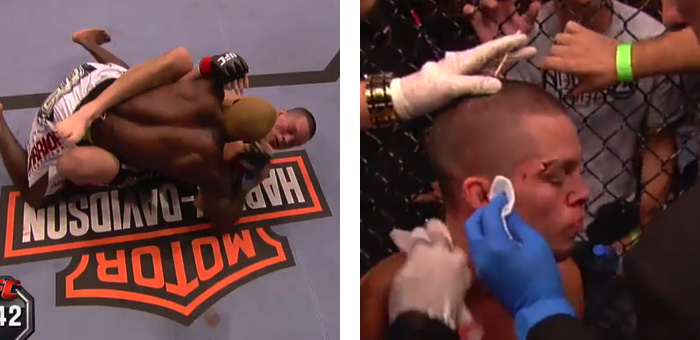 Also early in a 1st round, after ground and pound exchange, Nate suffers his worst documented right eyebrow laceration. It appears very jagged and deep and possibly needed a multi-layered closure. Nate finished Guillard with a 2nd round guillotine submission.4. December 2012 vs. Benson Henderson — Decision Loss
Also early in a 1st round, after ground and pound exchange, Nate suffers his worst documented right eyebrow laceration. It appears very jagged and deep and possibly needed a multi-layered closure. Nate finished Guillard with a 2nd round guillotine submission.4. December 2012 vs. Benson Henderson — Decision Loss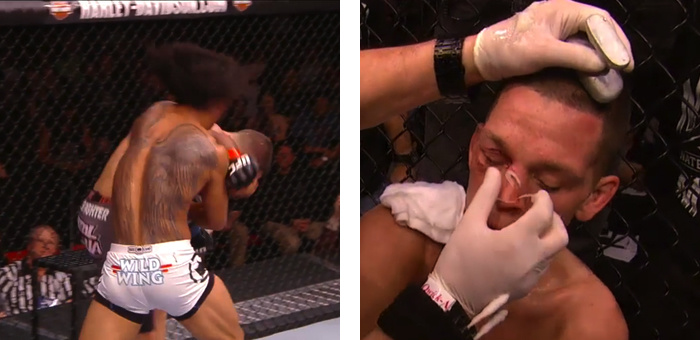 Midway through the 2nd round a Henderson elbow caught Diaz on the right eyebrow. This laceration was lower and more towards the nose than previous lacerations, but still contributes to the areas scar tissue and vision loss. He lost by unanimous decision.5. April 2013 vs. Josh Thomson — TKO LOSS
Midway through the 2nd round a Henderson elbow caught Diaz on the right eyebrow. This laceration was lower and more towards the nose than previous lacerations, but still contributes to the areas scar tissue and vision loss. He lost by unanimous decision.5. April 2013 vs. Josh Thomson — TKO LOSS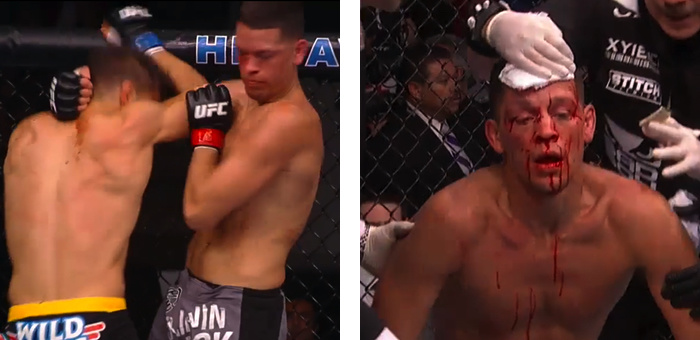 A Thomson elbow opened Nate's right eyebrow in the early 2nd. In that same round Thomson connected with a head kick unseen by a bloodied and pre-occupied Diaz. This was Nate's first and only TKO loss in the UFC, and perhaps avoidable if it weren't for the blood. Unseen strikes are precisely what a Ringside Physician hopes to avoid as they have higher chances of concussion and brain injury. For this reason, facial lacerations are the most frequent cause of fight stoppages.6. December 2014 vs. Rafael Dos Anjos — Decision Loss
A Thomson elbow opened Nate's right eyebrow in the early 2nd. In that same round Thomson connected with a head kick unseen by a bloodied and pre-occupied Diaz. This was Nate's first and only TKO loss in the UFC, and perhaps avoidable if it weren't for the blood. Unseen strikes are precisely what a Ringside Physician hopes to avoid as they have higher chances of concussion and brain injury. For this reason, facial lacerations are the most frequent cause of fight stoppages.6. December 2014 vs. Rafael Dos Anjos — Decision Loss During the mid 2nd round an RDA overhand left was the perpetrating strike. Later in the 2nd the referee called a temporary medical stoppage due to profuse bleeding from the area—before RDA could capitalize. Diaz went on to lose via unanimous decision.7. March 2016 vs. McGregor I — Submission Win
During the mid 2nd round an RDA overhand left was the perpetrating strike. Later in the 2nd the referee called a temporary medical stoppage due to profuse bleeding from the area—before RDA could capitalize. Diaz went on to lose via unanimous decision.7. March 2016 vs. McGregor I — Submission Win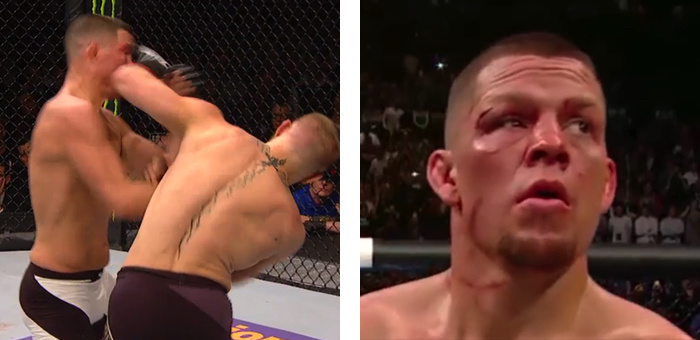 An overhand left in the 1st round was the inciting strike at UFC 196. Nate continued to fight well from his feet, but finished the fight with a rear naked choke.8. August 2016 vs. McGregor II — Decision Loss
An overhand left in the 1st round was the inciting strike at UFC 196. Nate continued to fight well from his feet, but finished the fight with a rear naked choke.8. August 2016 vs. McGregor II — Decision Loss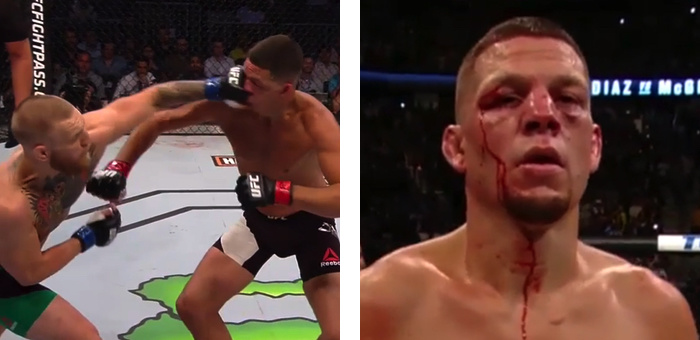 Just five months after their first fight, a quick turn around for Nate's right eyebrow, a McGregor overhand left in the 2nd round was the inciting strike. However unable to submit McGregor, Diaz went on to lose via split decision.+ + +THE 80% RULE
Just five months after their first fight, a quick turn around for Nate's right eyebrow, a McGregor overhand left in the 2nd round was the inciting strike. However unable to submit McGregor, Diaz went on to lose via split decision.+ + +THE 80% RULE
To understand why Nate's problem isn't going away we only need to look as far as the main tenant of wound healing. The tensile strength of a wound repair will reach a maximum of 80% of the previous pre-injury strength.This maximum strength is achieved after 3 months of healing and is why most MMA organizations, both amateur and professional, issue a mandatory 3 month no contact/sparing suspension to any fighter who has suffered a laceration. The scar may continue to improve cosmetically beyond 3 months, but the strength is capped at 80%.What does this mean for Diaz?
It means that after Diaz suffered his first brow laceration and repair, even if it healed perfectly and was done by the most skilled plastic surgeon, the scar tissue would reach only 80% of the areas previous tensile strength. Each subsequent laceration of the scarred area will cause a further decrease in tensile strength. There have been no studies regarding repeat facial lacerations, but it is safe to estimate that after the eight documented lacerations—and likely more undocumented—Diaz' right brow is about 50% as strong as a normal brow. Unless he can avoid being hit in this area, which is next to impossible, Diaz will have to deal with bleeding for the rest of his career.Scar tissue bleeds more
At even 6-12 months post injury the area is still healing and has increased capillary blood flow. Every time the area opens it will be more difficult or in Diaz' case, impossible, for the cutman to control.Scar Revision
A likely option for Diaz would be a consultation with a plastic surgeon, who can assess if scar revision is possible. His brother Nick already had that done it and even had his supraorbital ridge smoothed out. During scar revision the scar is removed and the surrounding healthy tissue is joined together. This would restore Diaz back to 80% tensile strength—however if he chose to use cadaver tissue, some plastic surgeons claim to obtain 90-100% tensile strength.What is the lesson to learn?
Try to avoid elbows and knees as much as possible, besides a bare knuckle these hard and flat surfaces are better at lacerating than any other part of the human body. Also, just avoid getting cut at all costs—all it takes is the first one. This includes street fights and especially bare knuckle fights—which may seem like a good test or opportunity to show off all the little tricks you've been learning in the gym, but depending on what area of the world you hail there is always the possibility of the bystander sucker punch, the Hawaiian False Crack, or the Southern Bushwack.Regarding Diaz vs. McGregor III
In terms of his facial lacerations, it certainly works in Diaz' advantage that the completion of the trilogy has been put on the shelf. If he wants to maximize his chances of winning he should give his lacerations as much time as possible to heal, or maybe opt for plastic surgery. Three months is the minimum, but because of his repeat lacerations, a year or more will help decrease blood flow if his right brow does open up again.
Advertisement
Advertisement



Advertisement





Advertisement
To understand why Nate's problem isn't going away we only need to look as far as the main tenant of wound healing. The tensile strength of a wound repair will reach a maximum of 80% of the previous pre-injury strength.This maximum strength is achieved after 3 months of healing and is why most MMA organizations, both amateur and professional, issue a mandatory 3 month no contact/sparing suspension to any fighter who has suffered a laceration. The scar may continue to improve cosmetically beyond 3 months, but the strength is capped at 80%.What does this mean for Diaz?
It means that after Diaz suffered his first brow laceration and repair, even if it healed perfectly and was done by the most skilled plastic surgeon, the scar tissue would reach only 80% of the areas previous tensile strength. Each subsequent laceration of the scarred area will cause a further decrease in tensile strength. There have been no studies regarding repeat facial lacerations, but it is safe to estimate that after the eight documented lacerations—and likely more undocumented—Diaz' right brow is about 50% as strong as a normal brow. Unless he can avoid being hit in this area, which is next to impossible, Diaz will have to deal with bleeding for the rest of his career.Scar tissue bleeds more
At even 6-12 months post injury the area is still healing and has increased capillary blood flow. Every time the area opens it will be more difficult or in Diaz' case, impossible, for the cutman to control.Scar Revision
A likely option for Diaz would be a consultation with a plastic surgeon, who can assess if scar revision is possible. His brother Nick already had that done it and even had his supraorbital ridge smoothed out. During scar revision the scar is removed and the surrounding healthy tissue is joined together. This would restore Diaz back to 80% tensile strength—however if he chose to use cadaver tissue, some plastic surgeons claim to obtain 90-100% tensile strength.What is the lesson to learn?
Try to avoid elbows and knees as much as possible, besides a bare knuckle these hard and flat surfaces are better at lacerating than any other part of the human body. Also, just avoid getting cut at all costs—all it takes is the first one. This includes street fights and especially bare knuckle fights—which may seem like a good test or opportunity to show off all the little tricks you've been learning in the gym, but depending on what area of the world you hail there is always the possibility of the bystander sucker punch, the Hawaiian False Crack, or the Southern Bushwack.Regarding Diaz vs. McGregor III
In terms of his facial lacerations, it certainly works in Diaz' advantage that the completion of the trilogy has been put on the shelf. If he wants to maximize his chances of winning he should give his lacerations as much time as possible to heal, or maybe opt for plastic surgery. Three months is the minimum, but because of his repeat lacerations, a year or more will help decrease blood flow if his right brow does open up again.